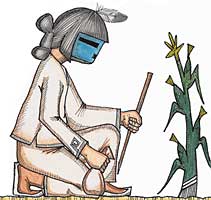Introduction (Spanish Version)
Las Vías del Noroeste focuses on cultural relations between indigenous peoples in the U.S. Southwest and the Mexican Northwest. The seminar serves to foment comparative analysis and reflection on this macro-region, integrating issues across fields such as:
- Ethnobotany, ritual plants, healing, and culinary traditions
- Ecology and concepts of earth stewardship
- Water management, dry-farming, irrigation, concepts of water use in arid lands
- Pilgrimage and sacred places
- Lexical concepts relating to geography and ecology
- Interdisciplinary and collaborative approaches to research in these topic areas, including art, archaeology, iconography, linguistics, geography, botany, and traditional knowledge and methods
Environmental Problems Cross International Borders
The Southwestern U.S. is plagued by water shortages, drought, soil erosion, and explosive unplanned population growth. Northwest Mexico likewise faces environmental challenges. At the root of many of these problems is the fact that few Americans and Mexicans of primarily European descent understand how desert climates and hydrological cycles work. Fewer understand indigenous views of ecology and agriculture.
Academics, Indigenous Farmers, Artists, and Cultural Specialists Seek Solutions
The Common Roots Conference brought academics, indigenous farmers, artists, and cultural specialists together to discuss common interests in our various idioms-through formal presentations and informal discussions in our differing languages, our writing, and artistic expression. Together, we visited farms and fields in search for ways to investigate, understand, and explain indigenous views of climate, hydrology, agriculture, wild plants, medicine, landscape, and most important: human roles of stewardship.
Conference Participants Employ a Macro-Regional Approach
The Universidad Nacional Autónoma de México sponsored the first two conferences in Mexico City and Real de Catorce, San Luis Potosí. This was the first conference to meet in the United States, where the study of ancient relationships between the Southwest and Mesoamerica has been hindered over the last forty years by dominant theoretical frameworks that rejected the study of migration, pilgrimage, trade, religion, and art in favor of generalizations about human behavior and adaptation to environmental change. Lack of archaeological and historical studies of Northern Mexico also presented an obstacle to truly regional investigations. Mexican scholars have tended to focus on Central Mexico, and have not until recently begun to look to the northwest. This conference was the third in a series that explores the deep historical connections between Mexico and the Southwestern U.S.
Together We Learn through Collaboration
Our goal is to bring together people who have traditionally maintained relationships with each other for thousands of years, but now are separated by the international border. How is their shared past important today? Though the various Uto-Aztecan languages are no longer mutually intelligible, they still have in common metaphors about life, farming, ecology, and landscape (for example the “water mountain,” or “altepetl” in Nahuatl, as a focus of community and as the source of life-giving water for crops). Such metaphors, together with foodways, medicinal practices, farming techniques and crops, and ritual practices including pilgrimage and caring for landscape shrines, are part of a “big picture” of earth stewardship in “Greater Mesoamerica.”

